Organisational Change Management Report: NHS Crisis Analysis
VerifiedAdded on 2023/04/21
|10
|2868
|298
Report
AI Summary
This report delves into the organizational change management challenges faced by the NHS in the UK, specifically addressing the crisis of high staff turnover. It begins by identifying the triggers and drivers of the crisis, such as high stress levels, discrimination, and unacceptable working conditions, as revealed by recent NHS staff surveys. The report then outlines the stages of crisis management, including pre-crisis, crisis response, and post-crisis phases, and applies relevant theories like structural functional systems theory and the diffusion of innovation theory. It proceeds to evaluate appropriate approaches to change, emphasizing the importance of meeting employees' needs for belonging, competence, and autonomy. The analysis highlights the impact of leadership and organizational culture on change, identifying the role of change agents in the process. Furthermore, the report addresses barriers to change, such as over-controlling leadership and poor communication, and suggests strategies for overcoming resistance. A comparison with organizations like the WHO is also provided, highlighting the importance of staff health and safety. The report concludes by summarizing key findings and recommendations for effective crisis management and organizational change within the NHS.
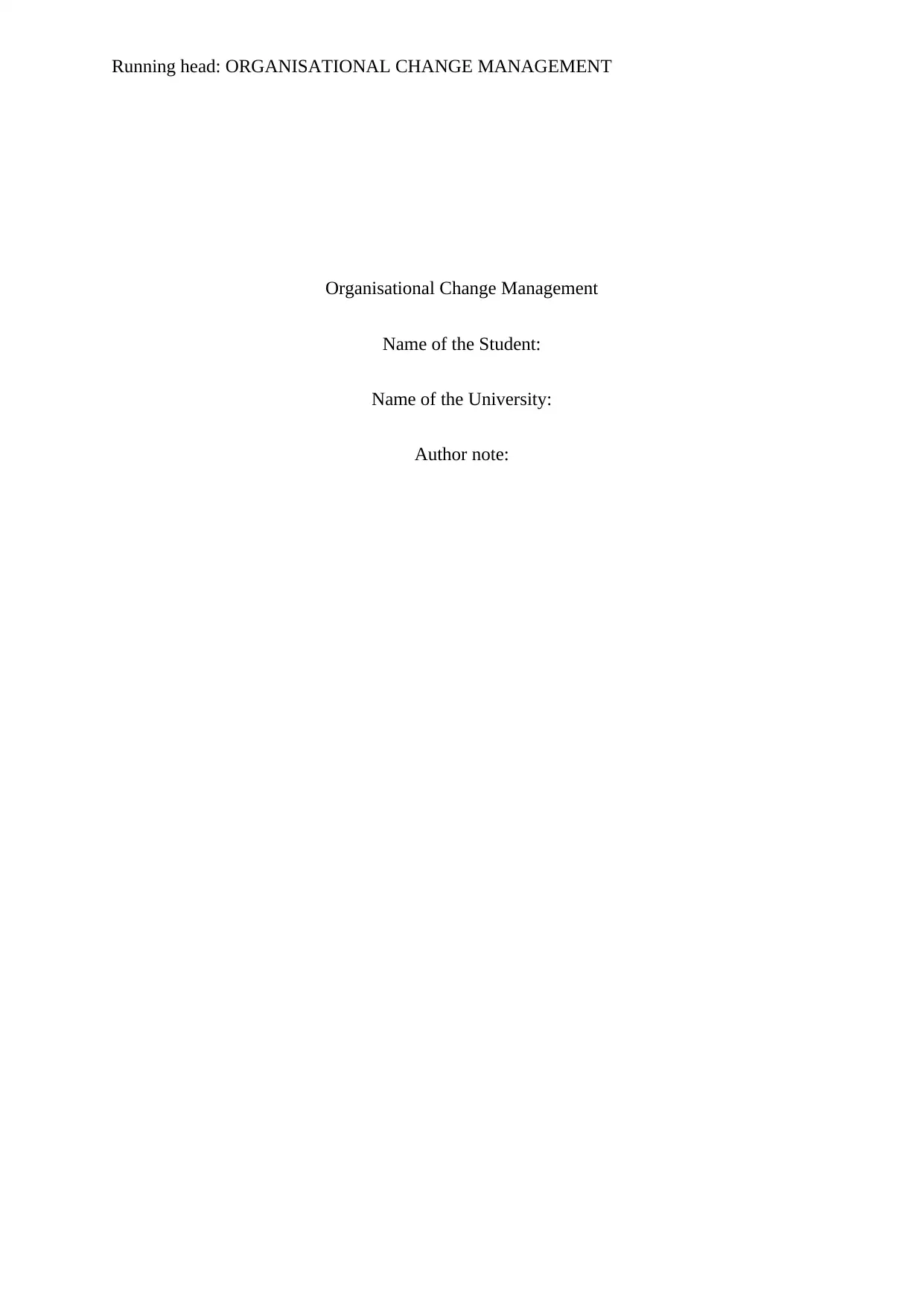
Running head: ORGANISATIONAL CHANGE MANAGEMENT
Organisational Change Management
Name of the Student:
Name of the University:
Author note:
Organisational Change Management
Name of the Student:
Name of the University:
Author note:
Paraphrase This Document
Need a fresh take? Get an instant paraphrase of this document with our AI Paraphraser
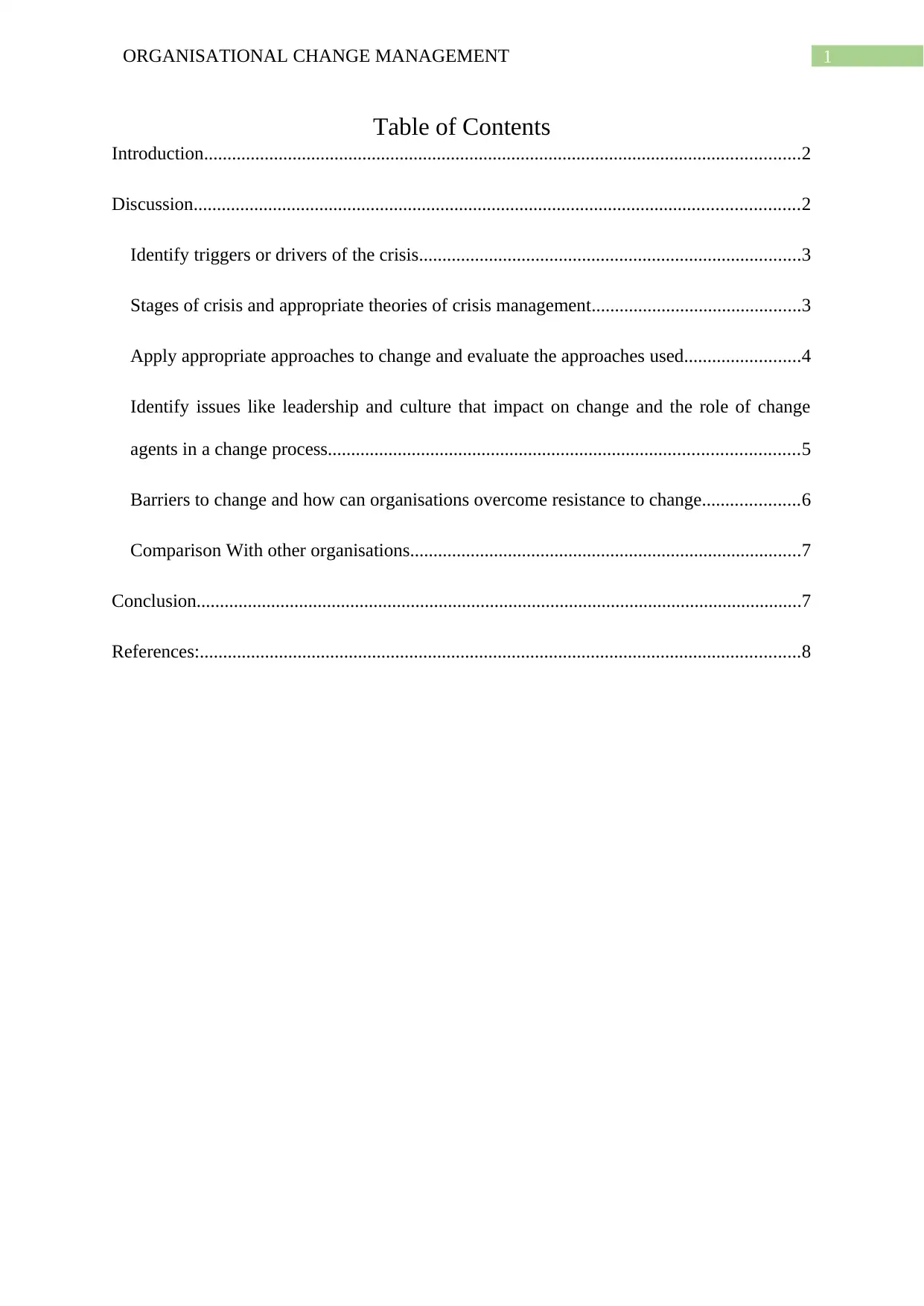
1ORGANISATIONAL CHANGE MANAGEMENT
Table of Contents
Introduction................................................................................................................................2
Discussion..................................................................................................................................2
Identify triggers or drivers of the crisis..................................................................................3
Stages of crisis and appropriate theories of crisis management.............................................3
Apply appropriate approaches to change and evaluate the approaches used.........................4
Identify issues like leadership and culture that impact on change and the role of change
agents in a change process.....................................................................................................5
Barriers to change and how can organisations overcome resistance to change.....................6
Comparison With other organisations....................................................................................7
Conclusion..................................................................................................................................7
References:.................................................................................................................................8
Table of Contents
Introduction................................................................................................................................2
Discussion..................................................................................................................................2
Identify triggers or drivers of the crisis..................................................................................3
Stages of crisis and appropriate theories of crisis management.............................................3
Apply appropriate approaches to change and evaluate the approaches used.........................4
Identify issues like leadership and culture that impact on change and the role of change
agents in a change process.....................................................................................................5
Barriers to change and how can organisations overcome resistance to change.....................6
Comparison With other organisations....................................................................................7
Conclusion..................................................................................................................................7
References:.................................................................................................................................8
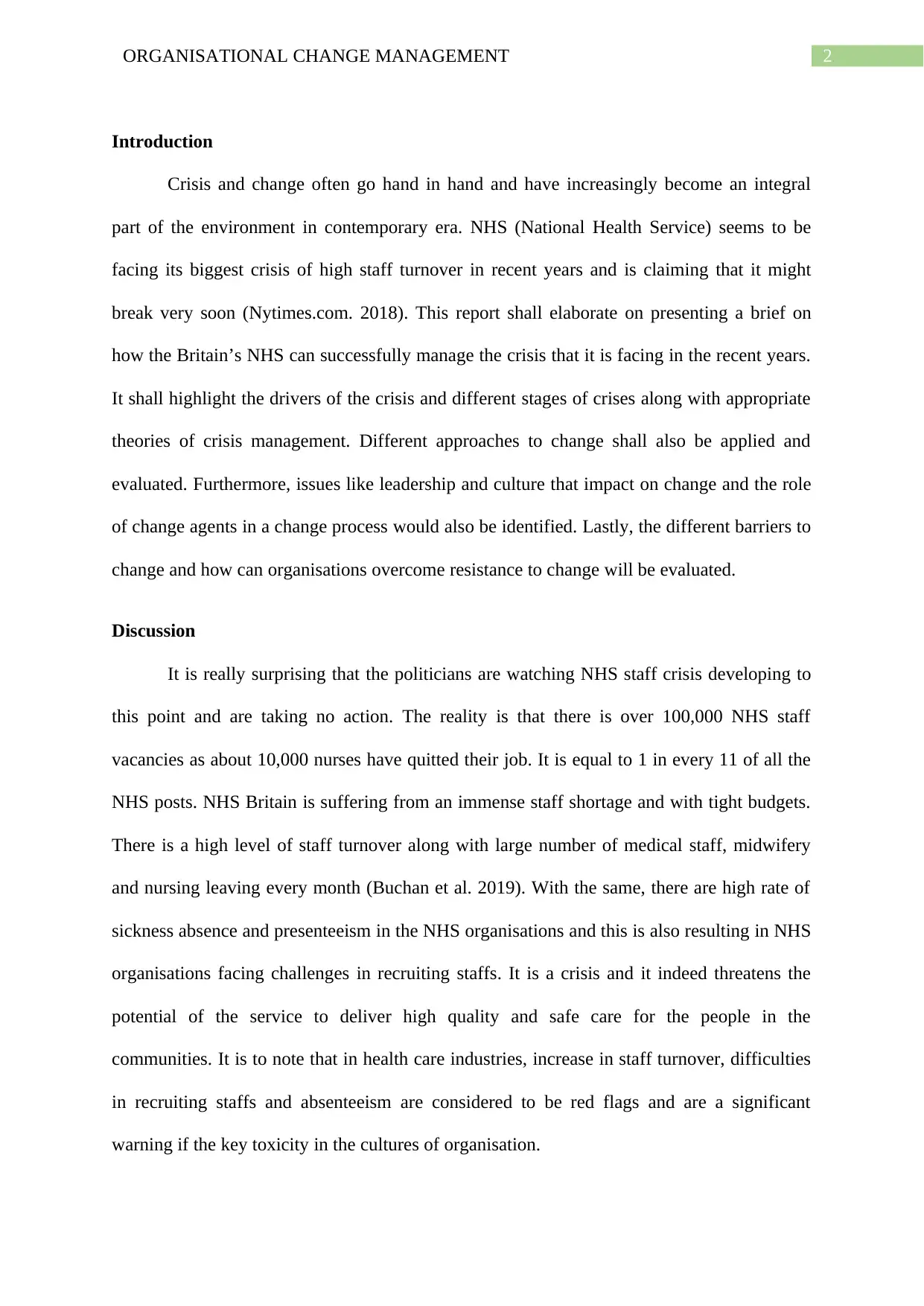
2ORGANISATIONAL CHANGE MANAGEMENT
Introduction
Crisis and change often go hand in hand and have increasingly become an integral
part of the environment in contemporary era. NHS (National Health Service) seems to be
facing its biggest crisis of high staff turnover in recent years and is claiming that it might
break very soon (Nytimes.com. 2018). This report shall elaborate on presenting a brief on
how the Britain’s NHS can successfully manage the crisis that it is facing in the recent years.
It shall highlight the drivers of the crisis and different stages of crises along with appropriate
theories of crisis management. Different approaches to change shall also be applied and
evaluated. Furthermore, issues like leadership and culture that impact on change and the role
of change agents in a change process would also be identified. Lastly, the different barriers to
change and how can organisations overcome resistance to change will be evaluated.
Discussion
It is really surprising that the politicians are watching NHS staff crisis developing to
this point and are taking no action. The reality is that there is over 100,000 NHS staff
vacancies as about 10,000 nurses have quitted their job. It is equal to 1 in every 11 of all the
NHS posts. NHS Britain is suffering from an immense staff shortage and with tight budgets.
There is a high level of staff turnover along with large number of medical staff, midwifery
and nursing leaving every month (Buchan et al. 2019). With the same, there are high rate of
sickness absence and presenteeism in the NHS organisations and this is also resulting in NHS
organisations facing challenges in recruiting staffs. It is a crisis and it indeed threatens the
potential of the service to deliver high quality and safe care for the people in the
communities. It is to note that in health care industries, increase in staff turnover, difficulties
in recruiting staffs and absenteeism are considered to be red flags and are a significant
warning if the key toxicity in the cultures of organisation.
Introduction
Crisis and change often go hand in hand and have increasingly become an integral
part of the environment in contemporary era. NHS (National Health Service) seems to be
facing its biggest crisis of high staff turnover in recent years and is claiming that it might
break very soon (Nytimes.com. 2018). This report shall elaborate on presenting a brief on
how the Britain’s NHS can successfully manage the crisis that it is facing in the recent years.
It shall highlight the drivers of the crisis and different stages of crises along with appropriate
theories of crisis management. Different approaches to change shall also be applied and
evaluated. Furthermore, issues like leadership and culture that impact on change and the role
of change agents in a change process would also be identified. Lastly, the different barriers to
change and how can organisations overcome resistance to change will be evaluated.
Discussion
It is really surprising that the politicians are watching NHS staff crisis developing to
this point and are taking no action. The reality is that there is over 100,000 NHS staff
vacancies as about 10,000 nurses have quitted their job. It is equal to 1 in every 11 of all the
NHS posts. NHS Britain is suffering from an immense staff shortage and with tight budgets.
There is a high level of staff turnover along with large number of medical staff, midwifery
and nursing leaving every month (Buchan et al. 2019). With the same, there are high rate of
sickness absence and presenteeism in the NHS organisations and this is also resulting in NHS
organisations facing challenges in recruiting staffs. It is a crisis and it indeed threatens the
potential of the service to deliver high quality and safe care for the people in the
communities. It is to note that in health care industries, increase in staff turnover, difficulties
in recruiting staffs and absenteeism are considered to be red flags and are a significant
warning if the key toxicity in the cultures of organisation.
⊘ This is a preview!⊘
Do you want full access?
Subscribe today to unlock all pages.

Trusted by 1+ million students worldwide
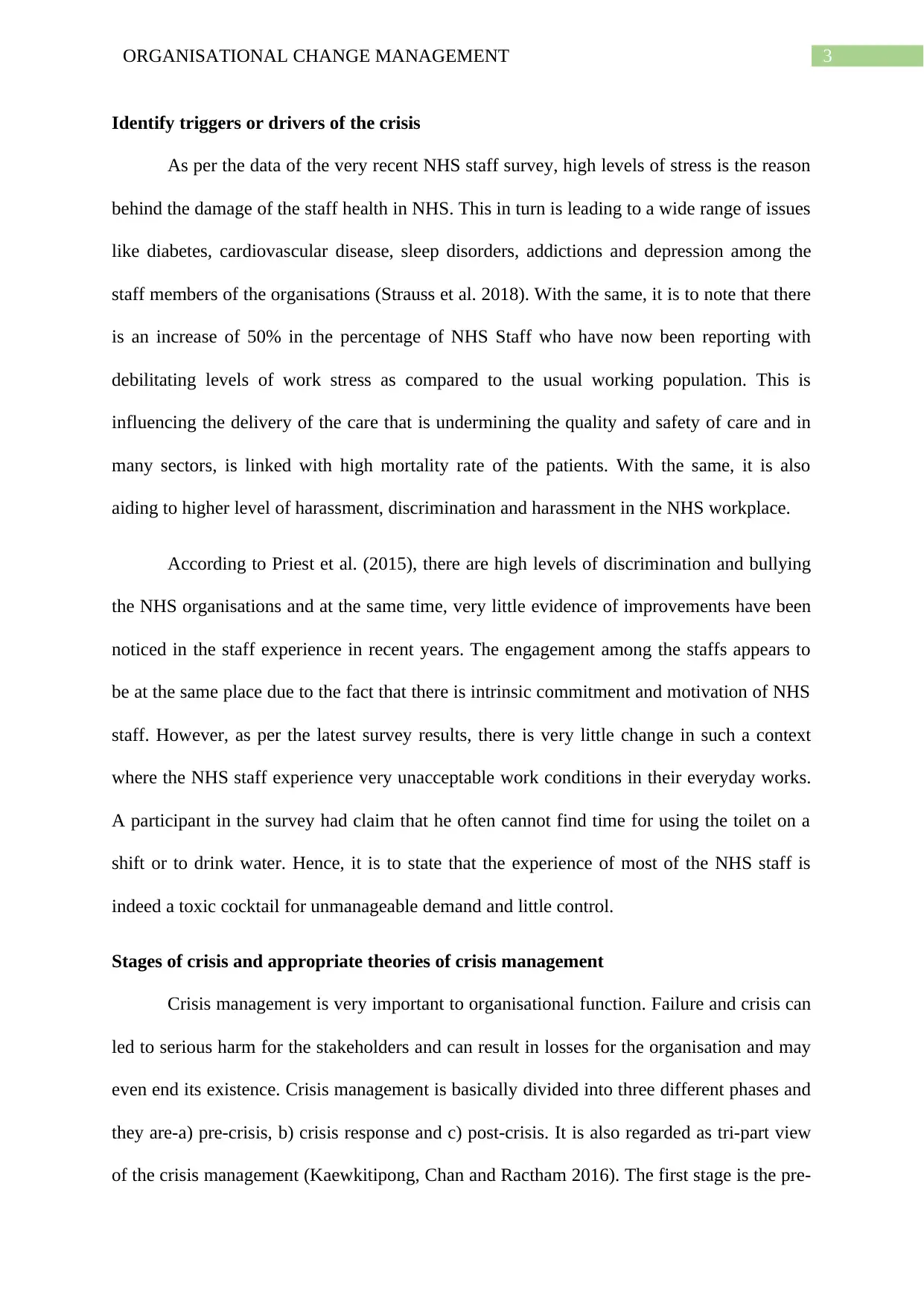
3ORGANISATIONAL CHANGE MANAGEMENT
Identify triggers or drivers of the crisis
As per the data of the very recent NHS staff survey, high levels of stress is the reason
behind the damage of the staff health in NHS. This in turn is leading to a wide range of issues
like diabetes, cardiovascular disease, sleep disorders, addictions and depression among the
staff members of the organisations (Strauss et al. 2018). With the same, it is to note that there
is an increase of 50% in the percentage of NHS Staff who have now been reporting with
debilitating levels of work stress as compared to the usual working population. This is
influencing the delivery of the care that is undermining the quality and safety of care and in
many sectors, is linked with high mortality rate of the patients. With the same, it is also
aiding to higher level of harassment, discrimination and harassment in the NHS workplace.
According to Priest et al. (2015), there are high levels of discrimination and bullying
the NHS organisations and at the same time, very little evidence of improvements have been
noticed in the staff experience in recent years. The engagement among the staffs appears to
be at the same place due to the fact that there is intrinsic commitment and motivation of NHS
staff. However, as per the latest survey results, there is very little change in such a context
where the NHS staff experience very unacceptable work conditions in their everyday works.
A participant in the survey had claim that he often cannot find time for using the toilet on a
shift or to drink water. Hence, it is to state that the experience of most of the NHS staff is
indeed a toxic cocktail for unmanageable demand and little control.
Stages of crisis and appropriate theories of crisis management
Crisis management is very important to organisational function. Failure and crisis can
led to serious harm for the stakeholders and can result in losses for the organisation and may
even end its existence. Crisis management is basically divided into three different phases and
they are-a) pre-crisis, b) crisis response and c) post-crisis. It is also regarded as tri-part view
of the crisis management (Kaewkitipong, Chan and Ractham 2016). The first stage is the pre-
Identify triggers or drivers of the crisis
As per the data of the very recent NHS staff survey, high levels of stress is the reason
behind the damage of the staff health in NHS. This in turn is leading to a wide range of issues
like diabetes, cardiovascular disease, sleep disorders, addictions and depression among the
staff members of the organisations (Strauss et al. 2018). With the same, it is to note that there
is an increase of 50% in the percentage of NHS Staff who have now been reporting with
debilitating levels of work stress as compared to the usual working population. This is
influencing the delivery of the care that is undermining the quality and safety of care and in
many sectors, is linked with high mortality rate of the patients. With the same, it is also
aiding to higher level of harassment, discrimination and harassment in the NHS workplace.
According to Priest et al. (2015), there are high levels of discrimination and bullying
the NHS organisations and at the same time, very little evidence of improvements have been
noticed in the staff experience in recent years. The engagement among the staffs appears to
be at the same place due to the fact that there is intrinsic commitment and motivation of NHS
staff. However, as per the latest survey results, there is very little change in such a context
where the NHS staff experience very unacceptable work conditions in their everyday works.
A participant in the survey had claim that he often cannot find time for using the toilet on a
shift or to drink water. Hence, it is to state that the experience of most of the NHS staff is
indeed a toxic cocktail for unmanageable demand and little control.
Stages of crisis and appropriate theories of crisis management
Crisis management is very important to organisational function. Failure and crisis can
led to serious harm for the stakeholders and can result in losses for the organisation and may
even end its existence. Crisis management is basically divided into three different phases and
they are-a) pre-crisis, b) crisis response and c) post-crisis. It is also regarded as tri-part view
of the crisis management (Kaewkitipong, Chan and Ractham 2016). The first stage is the pre-
Paraphrase This Document
Need a fresh take? Get an instant paraphrase of this document with our AI Paraphraser
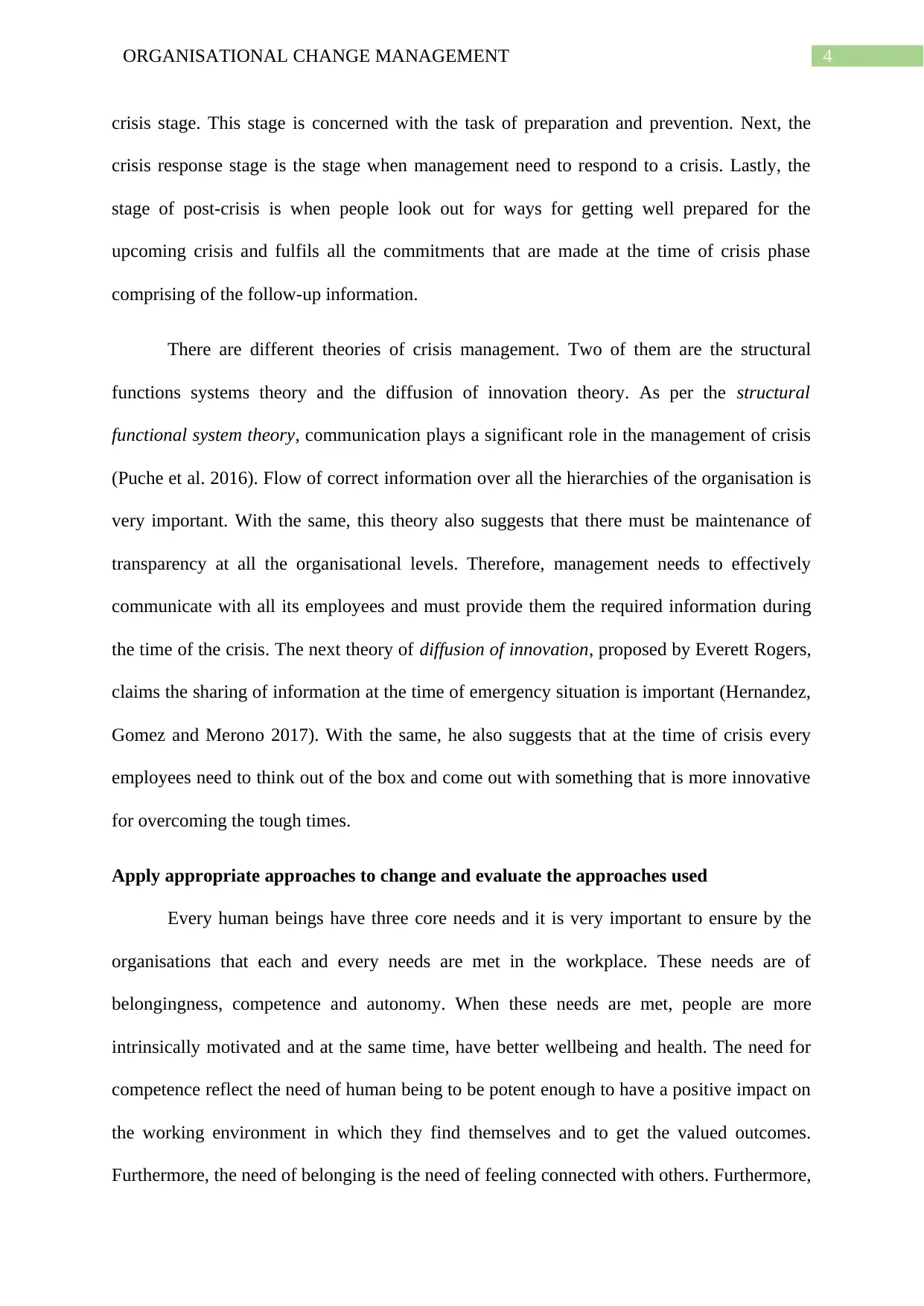
4ORGANISATIONAL CHANGE MANAGEMENT
crisis stage. This stage is concerned with the task of preparation and prevention. Next, the
crisis response stage is the stage when management need to respond to a crisis. Lastly, the
stage of post-crisis is when people look out for ways for getting well prepared for the
upcoming crisis and fulfils all the commitments that are made at the time of crisis phase
comprising of the follow-up information.
There are different theories of crisis management. Two of them are the structural
functions systems theory and the diffusion of innovation theory. As per the structural
functional system theory, communication plays a significant role in the management of crisis
(Puche et al. 2016). Flow of correct information over all the hierarchies of the organisation is
very important. With the same, this theory also suggests that there must be maintenance of
transparency at all the organisational levels. Therefore, management needs to effectively
communicate with all its employees and must provide them the required information during
the time of the crisis. The next theory of diffusion of innovation, proposed by Everett Rogers,
claims the sharing of information at the time of emergency situation is important (Hernandez,
Gomez and Merono 2017). With the same, he also suggests that at the time of crisis every
employees need to think out of the box and come out with something that is more innovative
for overcoming the tough times.
Apply appropriate approaches to change and evaluate the approaches used
Every human beings have three core needs and it is very important to ensure by the
organisations that each and every needs are met in the workplace. These needs are of
belongingness, competence and autonomy. When these needs are met, people are more
intrinsically motivated and at the same time, have better wellbeing and health. The need for
competence reflect the need of human being to be potent enough to have a positive impact on
the working environment in which they find themselves and to get the valued outcomes.
Furthermore, the need of belonging is the need of feeling connected with others. Furthermore,
crisis stage. This stage is concerned with the task of preparation and prevention. Next, the
crisis response stage is the stage when management need to respond to a crisis. Lastly, the
stage of post-crisis is when people look out for ways for getting well prepared for the
upcoming crisis and fulfils all the commitments that are made at the time of crisis phase
comprising of the follow-up information.
There are different theories of crisis management. Two of them are the structural
functions systems theory and the diffusion of innovation theory. As per the structural
functional system theory, communication plays a significant role in the management of crisis
(Puche et al. 2016). Flow of correct information over all the hierarchies of the organisation is
very important. With the same, this theory also suggests that there must be maintenance of
transparency at all the organisational levels. Therefore, management needs to effectively
communicate with all its employees and must provide them the required information during
the time of the crisis. The next theory of diffusion of innovation, proposed by Everett Rogers,
claims the sharing of information at the time of emergency situation is important (Hernandez,
Gomez and Merono 2017). With the same, he also suggests that at the time of crisis every
employees need to think out of the box and come out with something that is more innovative
for overcoming the tough times.
Apply appropriate approaches to change and evaluate the approaches used
Every human beings have three core needs and it is very important to ensure by the
organisations that each and every needs are met in the workplace. These needs are of
belongingness, competence and autonomy. When these needs are met, people are more
intrinsically motivated and at the same time, have better wellbeing and health. The need for
competence reflect the need of human being to be potent enough to have a positive impact on
the working environment in which they find themselves and to get the valued outcomes.
Furthermore, the need of belonging is the need of feeling connected with others. Furthermore,
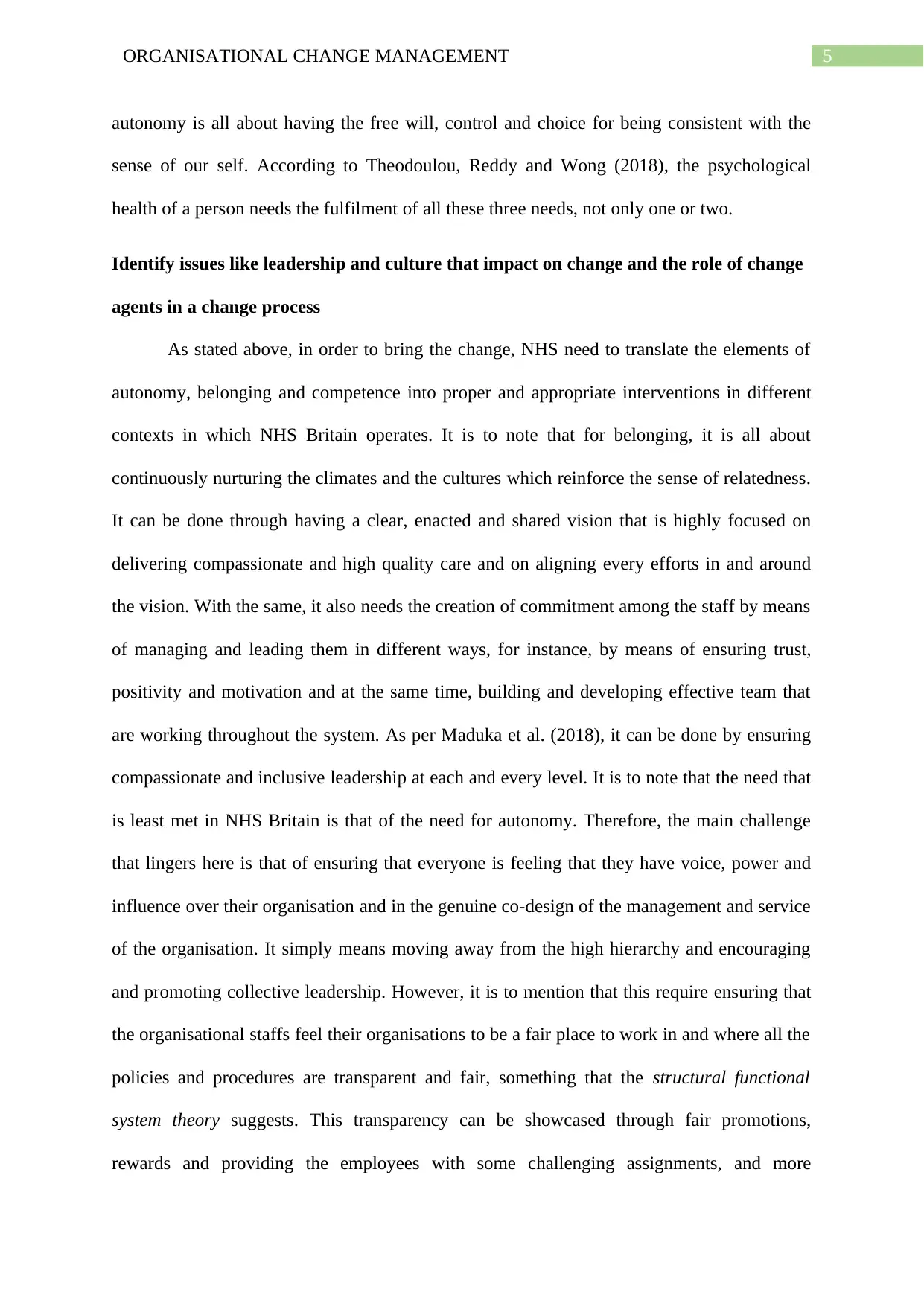
5ORGANISATIONAL CHANGE MANAGEMENT
autonomy is all about having the free will, control and choice for being consistent with the
sense of our self. According to Theodoulou, Reddy and Wong (2018), the psychological
health of a person needs the fulfilment of all these three needs, not only one or two.
Identify issues like leadership and culture that impact on change and the role of change
agents in a change process
As stated above, in order to bring the change, NHS need to translate the elements of
autonomy, belonging and competence into proper and appropriate interventions in different
contexts in which NHS Britain operates. It is to note that for belonging, it is all about
continuously nurturing the climates and the cultures which reinforce the sense of relatedness.
It can be done through having a clear, enacted and shared vision that is highly focused on
delivering compassionate and high quality care and on aligning every efforts in and around
the vision. With the same, it also needs the creation of commitment among the staff by means
of managing and leading them in different ways, for instance, by means of ensuring trust,
positivity and motivation and at the same time, building and developing effective team that
are working throughout the system. As per Maduka et al. (2018), it can be done by ensuring
compassionate and inclusive leadership at each and every level. It is to note that the need that
is least met in NHS Britain is that of the need for autonomy. Therefore, the main challenge
that lingers here is that of ensuring that everyone is feeling that they have voice, power and
influence over their organisation and in the genuine co-design of the management and service
of the organisation. It simply means moving away from the high hierarchy and encouraging
and promoting collective leadership. However, it is to mention that this require ensuring that
the organisational staffs feel their organisations to be a fair place to work in and where all the
policies and procedures are transparent and fair, something that the structural functional
system theory suggests. This transparency can be showcased through fair promotions,
rewards and providing the employees with some challenging assignments, and more
autonomy is all about having the free will, control and choice for being consistent with the
sense of our self. According to Theodoulou, Reddy and Wong (2018), the psychological
health of a person needs the fulfilment of all these three needs, not only one or two.
Identify issues like leadership and culture that impact on change and the role of change
agents in a change process
As stated above, in order to bring the change, NHS need to translate the elements of
autonomy, belonging and competence into proper and appropriate interventions in different
contexts in which NHS Britain operates. It is to note that for belonging, it is all about
continuously nurturing the climates and the cultures which reinforce the sense of relatedness.
It can be done through having a clear, enacted and shared vision that is highly focused on
delivering compassionate and high quality care and on aligning every efforts in and around
the vision. With the same, it also needs the creation of commitment among the staff by means
of managing and leading them in different ways, for instance, by means of ensuring trust,
positivity and motivation and at the same time, building and developing effective team that
are working throughout the system. As per Maduka et al. (2018), it can be done by ensuring
compassionate and inclusive leadership at each and every level. It is to note that the need that
is least met in NHS Britain is that of the need for autonomy. Therefore, the main challenge
that lingers here is that of ensuring that everyone is feeling that they have voice, power and
influence over their organisation and in the genuine co-design of the management and service
of the organisation. It simply means moving away from the high hierarchy and encouraging
and promoting collective leadership. However, it is to mention that this require ensuring that
the organisational staffs feel their organisations to be a fair place to work in and where all the
policies and procedures are transparent and fair, something that the structural functional
system theory suggests. This transparency can be showcased through fair promotions,
rewards and providing the employees with some challenging assignments, and more
⊘ This is a preview!⊘
Do you want full access?
Subscribe today to unlock all pages.

Trusted by 1+ million students worldwide
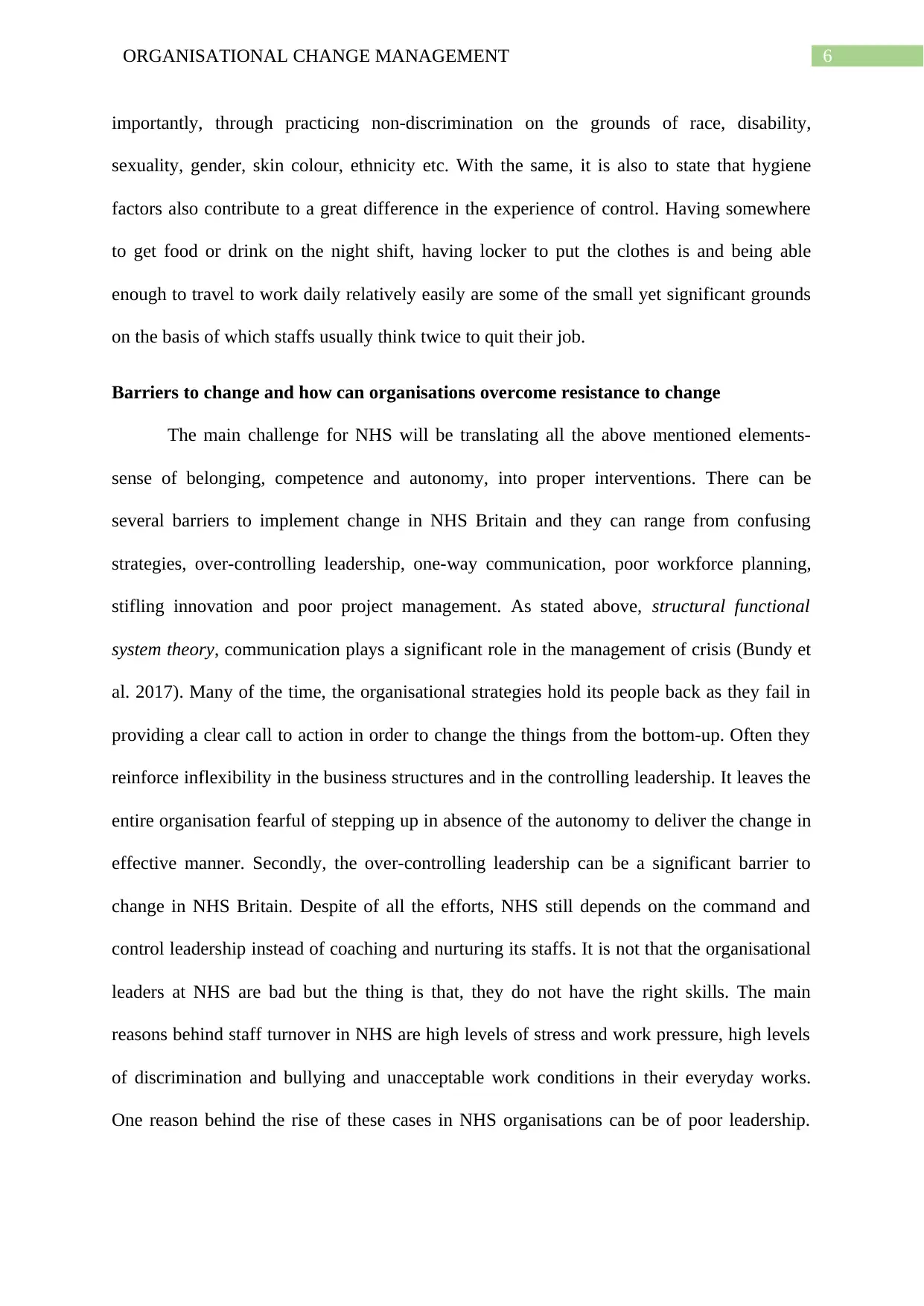
6ORGANISATIONAL CHANGE MANAGEMENT
importantly, through practicing non-discrimination on the grounds of race, disability,
sexuality, gender, skin colour, ethnicity etc. With the same, it is also to state that hygiene
factors also contribute to a great difference in the experience of control. Having somewhere
to get food or drink on the night shift, having locker to put the clothes is and being able
enough to travel to work daily relatively easily are some of the small yet significant grounds
on the basis of which staffs usually think twice to quit their job.
Barriers to change and how can organisations overcome resistance to change
The main challenge for NHS will be translating all the above mentioned elements-
sense of belonging, competence and autonomy, into proper interventions. There can be
several barriers to implement change in NHS Britain and they can range from confusing
strategies, over-controlling leadership, one-way communication, poor workforce planning,
stifling innovation and poor project management. As stated above, structural functional
system theory, communication plays a significant role in the management of crisis (Bundy et
al. 2017). Many of the time, the organisational strategies hold its people back as they fail in
providing a clear call to action in order to change the things from the bottom-up. Often they
reinforce inflexibility in the business structures and in the controlling leadership. It leaves the
entire organisation fearful of stepping up in absence of the autonomy to deliver the change in
effective manner. Secondly, the over-controlling leadership can be a significant barrier to
change in NHS Britain. Despite of all the efforts, NHS still depends on the command and
control leadership instead of coaching and nurturing its staffs. It is not that the organisational
leaders at NHS are bad but the thing is that, they do not have the right skills. The main
reasons behind staff turnover in NHS are high levels of stress and work pressure, high levels
of discrimination and bullying and unacceptable work conditions in their everyday works.
One reason behind the rise of these cases in NHS organisations can be of poor leadership.
importantly, through practicing non-discrimination on the grounds of race, disability,
sexuality, gender, skin colour, ethnicity etc. With the same, it is also to state that hygiene
factors also contribute to a great difference in the experience of control. Having somewhere
to get food or drink on the night shift, having locker to put the clothes is and being able
enough to travel to work daily relatively easily are some of the small yet significant grounds
on the basis of which staffs usually think twice to quit their job.
Barriers to change and how can organisations overcome resistance to change
The main challenge for NHS will be translating all the above mentioned elements-
sense of belonging, competence and autonomy, into proper interventions. There can be
several barriers to implement change in NHS Britain and they can range from confusing
strategies, over-controlling leadership, one-way communication, poor workforce planning,
stifling innovation and poor project management. As stated above, structural functional
system theory, communication plays a significant role in the management of crisis (Bundy et
al. 2017). Many of the time, the organisational strategies hold its people back as they fail in
providing a clear call to action in order to change the things from the bottom-up. Often they
reinforce inflexibility in the business structures and in the controlling leadership. It leaves the
entire organisation fearful of stepping up in absence of the autonomy to deliver the change in
effective manner. Secondly, the over-controlling leadership can be a significant barrier to
change in NHS Britain. Despite of all the efforts, NHS still depends on the command and
control leadership instead of coaching and nurturing its staffs. It is not that the organisational
leaders at NHS are bad but the thing is that, they do not have the right skills. The main
reasons behind staff turnover in NHS are high levels of stress and work pressure, high levels
of discrimination and bullying and unacceptable work conditions in their everyday works.
One reason behind the rise of these cases in NHS organisations can be of poor leadership.
Paraphrase This Document
Need a fresh take? Get an instant paraphrase of this document with our AI Paraphraser
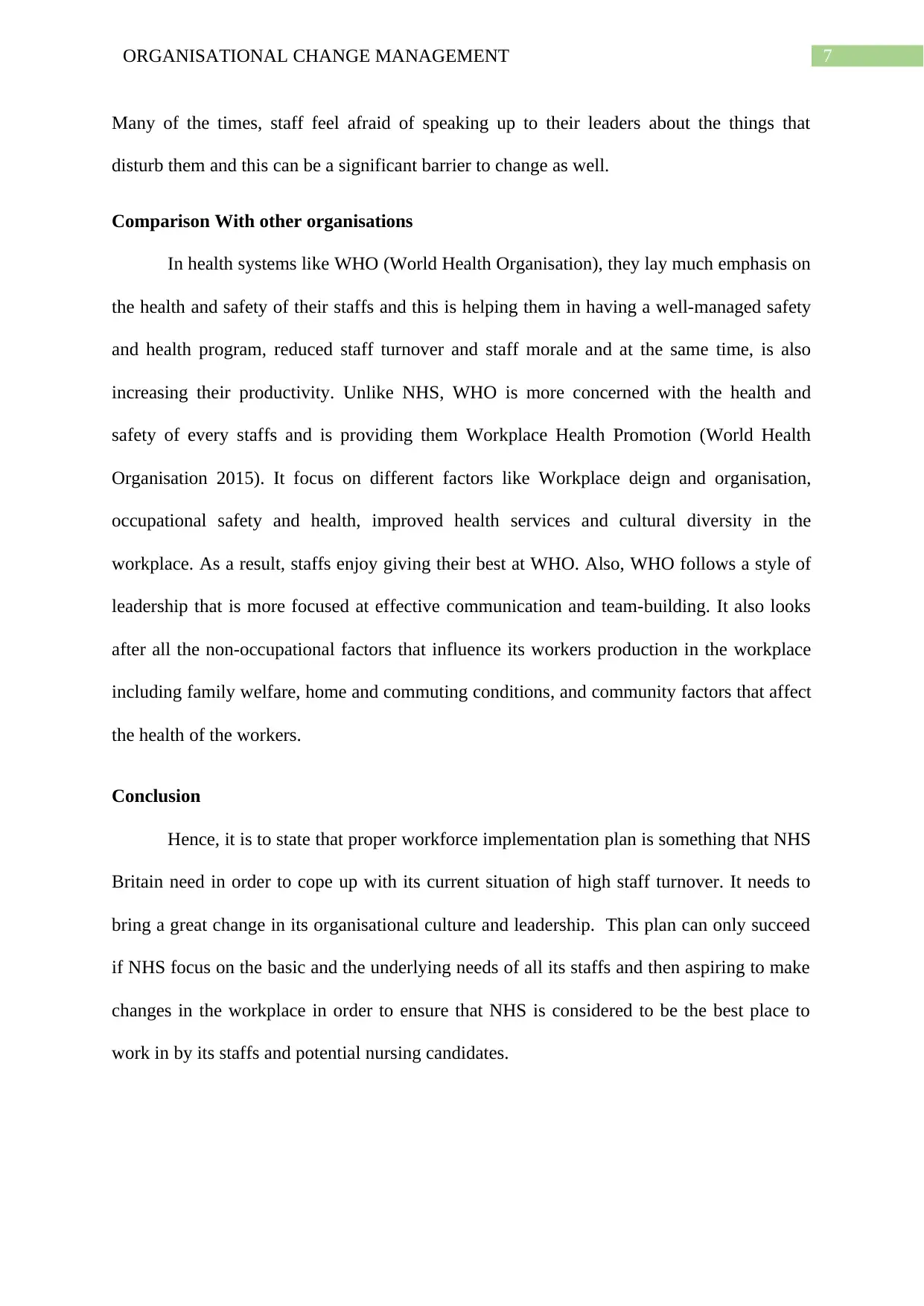
7ORGANISATIONAL CHANGE MANAGEMENT
Many of the times, staff feel afraid of speaking up to their leaders about the things that
disturb them and this can be a significant barrier to change as well.
Comparison With other organisations
In health systems like WHO (World Health Organisation), they lay much emphasis on
the health and safety of their staffs and this is helping them in having a well-managed safety
and health program, reduced staff turnover and staff morale and at the same time, is also
increasing their productivity. Unlike NHS, WHO is more concerned with the health and
safety of every staffs and is providing them Workplace Health Promotion (World Health
Organisation 2015). It focus on different factors like Workplace deign and organisation,
occupational safety and health, improved health services and cultural diversity in the
workplace. As a result, staffs enjoy giving their best at WHO. Also, WHO follows a style of
leadership that is more focused at effective communication and team-building. It also looks
after all the non-occupational factors that influence its workers production in the workplace
including family welfare, home and commuting conditions, and community factors that affect
the health of the workers.
Conclusion
Hence, it is to state that proper workforce implementation plan is something that NHS
Britain need in order to cope up with its current situation of high staff turnover. It needs to
bring a great change in its organisational culture and leadership. This plan can only succeed
if NHS focus on the basic and the underlying needs of all its staffs and then aspiring to make
changes in the workplace in order to ensure that NHS is considered to be the best place to
work in by its staffs and potential nursing candidates.
Many of the times, staff feel afraid of speaking up to their leaders about the things that
disturb them and this can be a significant barrier to change as well.
Comparison With other organisations
In health systems like WHO (World Health Organisation), they lay much emphasis on
the health and safety of their staffs and this is helping them in having a well-managed safety
and health program, reduced staff turnover and staff morale and at the same time, is also
increasing their productivity. Unlike NHS, WHO is more concerned with the health and
safety of every staffs and is providing them Workplace Health Promotion (World Health
Organisation 2015). It focus on different factors like Workplace deign and organisation,
occupational safety and health, improved health services and cultural diversity in the
workplace. As a result, staffs enjoy giving their best at WHO. Also, WHO follows a style of
leadership that is more focused at effective communication and team-building. It also looks
after all the non-occupational factors that influence its workers production in the workplace
including family welfare, home and commuting conditions, and community factors that affect
the health of the workers.
Conclusion
Hence, it is to state that proper workforce implementation plan is something that NHS
Britain need in order to cope up with its current situation of high staff turnover. It needs to
bring a great change in its organisational culture and leadership. This plan can only succeed
if NHS focus on the basic and the underlying needs of all its staffs and then aspiring to make
changes in the workplace in order to ensure that NHS is considered to be the best place to
work in by its staffs and potential nursing candidates.
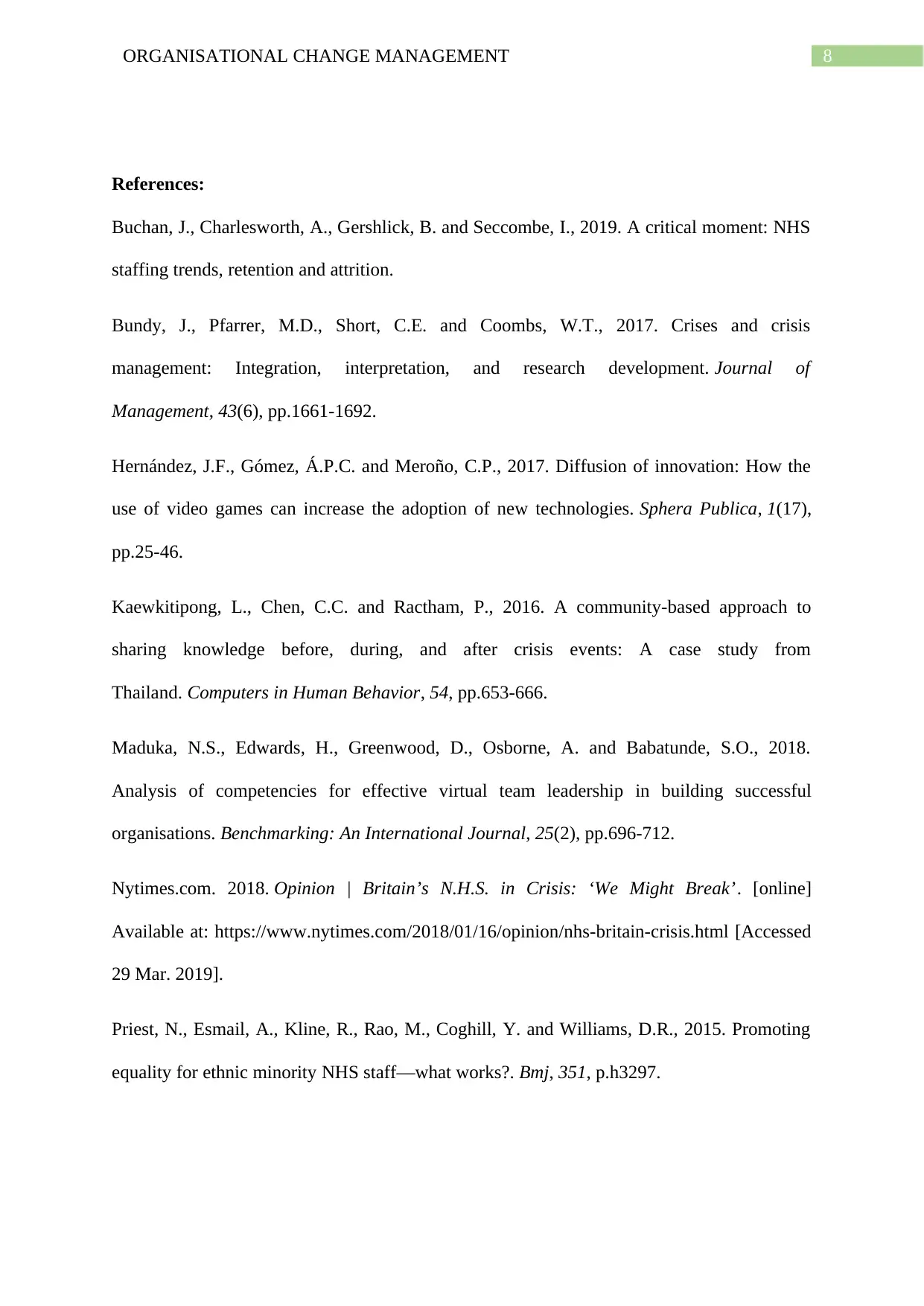
8ORGANISATIONAL CHANGE MANAGEMENT
References:
Buchan, J., Charlesworth, A., Gershlick, B. and Seccombe, I., 2019. A critical moment: NHS
staffing trends, retention and attrition.
Bundy, J., Pfarrer, M.D., Short, C.E. and Coombs, W.T., 2017. Crises and crisis
management: Integration, interpretation, and research development. Journal of
Management, 43(6), pp.1661-1692.
Hernández, J.F., Gómez, Á.P.C. and Meroño, C.P., 2017. Diffusion of innovation: How the
use of video games can increase the adoption of new technologies. Sphera Publica, 1(17),
pp.25-46.
Kaewkitipong, L., Chen, C.C. and Ractham, P., 2016. A community-based approach to
sharing knowledge before, during, and after crisis events: A case study from
Thailand. Computers in Human Behavior, 54, pp.653-666.
Maduka, N.S., Edwards, H., Greenwood, D., Osborne, A. and Babatunde, S.O., 2018.
Analysis of competencies for effective virtual team leadership in building successful
organisations. Benchmarking: An International Journal, 25(2), pp.696-712.
Nytimes.com. 2018. Opinion | Britain’s N.H.S. in Crisis: ‘We Might Break’. [online]
Available at: https://www.nytimes.com/2018/01/16/opinion/nhs-britain-crisis.html [Accessed
29 Mar. 2019].
Priest, N., Esmail, A., Kline, R., Rao, M., Coghill, Y. and Williams, D.R., 2015. Promoting
equality for ethnic minority NHS staff—what works?. Bmj, 351, p.h3297.
References:
Buchan, J., Charlesworth, A., Gershlick, B. and Seccombe, I., 2019. A critical moment: NHS
staffing trends, retention and attrition.
Bundy, J., Pfarrer, M.D., Short, C.E. and Coombs, W.T., 2017. Crises and crisis
management: Integration, interpretation, and research development. Journal of
Management, 43(6), pp.1661-1692.
Hernández, J.F., Gómez, Á.P.C. and Meroño, C.P., 2017. Diffusion of innovation: How the
use of video games can increase the adoption of new technologies. Sphera Publica, 1(17),
pp.25-46.
Kaewkitipong, L., Chen, C.C. and Ractham, P., 2016. A community-based approach to
sharing knowledge before, during, and after crisis events: A case study from
Thailand. Computers in Human Behavior, 54, pp.653-666.
Maduka, N.S., Edwards, H., Greenwood, D., Osborne, A. and Babatunde, S.O., 2018.
Analysis of competencies for effective virtual team leadership in building successful
organisations. Benchmarking: An International Journal, 25(2), pp.696-712.
Nytimes.com. 2018. Opinion | Britain’s N.H.S. in Crisis: ‘We Might Break’. [online]
Available at: https://www.nytimes.com/2018/01/16/opinion/nhs-britain-crisis.html [Accessed
29 Mar. 2019].
Priest, N., Esmail, A., Kline, R., Rao, M., Coghill, Y. and Williams, D.R., 2015. Promoting
equality for ethnic minority NHS staff—what works?. Bmj, 351, p.h3297.
⊘ This is a preview!⊘
Do you want full access?
Subscribe today to unlock all pages.

Trusted by 1+ million students worldwide
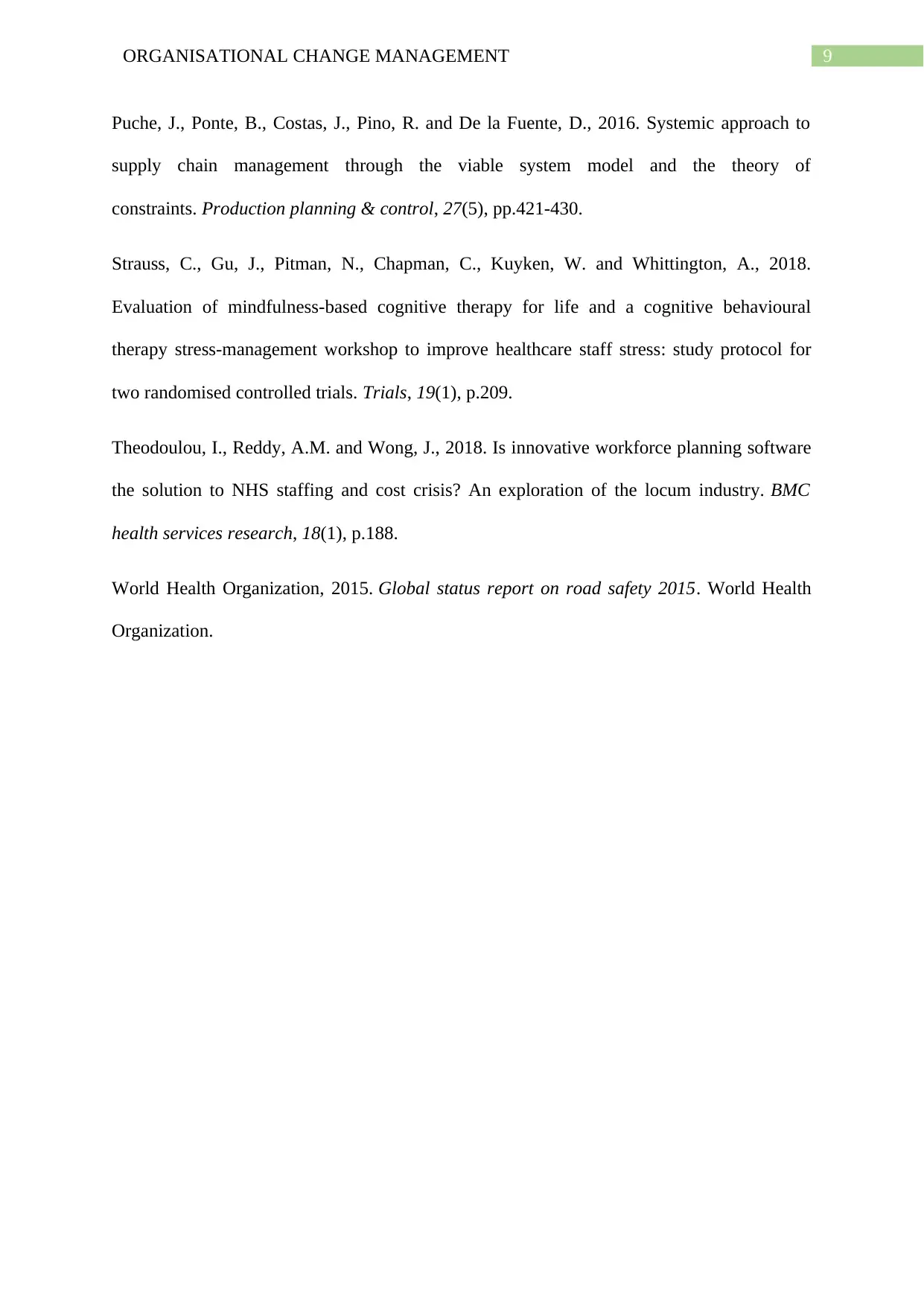
9ORGANISATIONAL CHANGE MANAGEMENT
Puche, J., Ponte, B., Costas, J., Pino, R. and De la Fuente, D., 2016. Systemic approach to
supply chain management through the viable system model and the theory of
constraints. Production planning & control, 27(5), pp.421-430.
Strauss, C., Gu, J., Pitman, N., Chapman, C., Kuyken, W. and Whittington, A., 2018.
Evaluation of mindfulness-based cognitive therapy for life and a cognitive behavioural
therapy stress-management workshop to improve healthcare staff stress: study protocol for
two randomised controlled trials. Trials, 19(1), p.209.
Theodoulou, I., Reddy, A.M. and Wong, J., 2018. Is innovative workforce planning software
the solution to NHS staffing and cost crisis? An exploration of the locum industry. BMC
health services research, 18(1), p.188.
World Health Organization, 2015. Global status report on road safety 2015. World Health
Organization.
Puche, J., Ponte, B., Costas, J., Pino, R. and De la Fuente, D., 2016. Systemic approach to
supply chain management through the viable system model and the theory of
constraints. Production planning & control, 27(5), pp.421-430.
Strauss, C., Gu, J., Pitman, N., Chapman, C., Kuyken, W. and Whittington, A., 2018.
Evaluation of mindfulness-based cognitive therapy for life and a cognitive behavioural
therapy stress-management workshop to improve healthcare staff stress: study protocol for
two randomised controlled trials. Trials, 19(1), p.209.
Theodoulou, I., Reddy, A.M. and Wong, J., 2018. Is innovative workforce planning software
the solution to NHS staffing and cost crisis? An exploration of the locum industry. BMC
health services research, 18(1), p.188.
World Health Organization, 2015. Global status report on road safety 2015. World Health
Organization.
1 out of 10
Related Documents
Your All-in-One AI-Powered Toolkit for Academic Success.
+13062052269
info@desklib.com
Available 24*7 on WhatsApp / Email
![[object Object]](/_next/static/media/star-bottom.7253800d.svg)
Unlock your academic potential
Copyright © 2020–2025 A2Z Services. All Rights Reserved. Developed and managed by ZUCOL.




